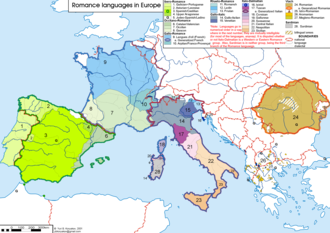Romance languages






Romance languages are a group of languages that evolved from Latin, the language of the Roman Empire. They are part of the Italic languages within the Indo-European language family. The most widely spoken Romance languages today are Spanish, Portuguese, French, Italian, and Romanian. These languages are native to Europe, Africa, and the Americas, reflecting the colonial history of the European powers that spoke them.
Origins and Evolution[edit]
The Romance languages originated from the Vulgar Latin spoken by soldiers, settlers, and merchants of the Roman Empire. As the power of Rome declined, Latin began to diverge into distinct regional forms, which gradually evolved into the separate Romance languages. This process was influenced by the pre-Roman languages of the conquered territories, as well as by subsequent invasions by Germanic tribes and the Moors in the Iberian Peninsula.
Characteristics[edit]
Despite their diversity, Romance languages share several linguistic characteristics due to their common Latin origin. These include similar grammatical structures, such as the use of gender for nouns and a preference for subject-verb-object word order. They also share a large portion of their vocabulary, though pronunciation and spelling can differ significantly.
Phonology[edit]
Romance languages exhibit a range of phonological changes from Latin, including the loss of certain consonant sounds and the development of new vowel sounds. These changes contribute to the distinct sound of each language.
Grammar[edit]
Grammatically, Romance languages are known for their use of inflections to indicate tense, mood, voice, number, and gender. The degree of inflection varies among the languages, with Romanian retaining a complex system of cases, while French has simplified its inflectional system considerably.
Vocabulary[edit]
The vocabulary of Romance languages is primarily derived from Latin, though each language has also borrowed words from neighboring languages, former colonies, and languages of cultural significance, such as English.
Distribution and Use[edit]
Today, Romance languages are spoken by more than 800 million people worldwide. Spanish and Portuguese, in particular, have spread far beyond their European origins, becoming the primary languages of most of Latin America. French is spoken in various regions across Africa, Canada, and Southeast Asia due to French colonialism. Italian has a significant number of speakers in Italy and parts of Switzerland, while Romanian is spoken primarily in Romania and Moldova.
Dialects[edit]
Each Romance language comprises a variety of dialects, some of which are significantly different from the standard language. For example, the Sicilian dialect in Italy or the Galician language in Spain, which is closely related to Portuguese.
Romance Languages in Education and Culture[edit]
Romance languages are prominent in the fields of education, literature, and international diplomacy. They are often taught as second languages, and their literatures include some of the most celebrated works in Western culture, such as those by Dante Alighieri, Miguel de Cervantes, and Victor Hugo.
Challenges and Preservation[edit]
While the major Romance languages are thriving, some regional dialects and languages face challenges in preservation and revitalization. Efforts are underway in various regions to protect these linguistic heritages.

This article is a linguistics stub. You can help WikiMD by expanding it!
Ad. Transform your life with W8MD's Budget GLP-1 injections from $75


W8MD offers a medical weight loss program to lose weight in Philadelphia. Our physician-supervised medical weight loss provides:
- Weight loss injections in NYC (generic and brand names):
- Zepbound / Mounjaro, Wegovy / Ozempic, Saxenda
- Most insurances accepted or discounted self-pay rates. We will obtain insurance prior authorizations if needed.
- Generic GLP1 weight loss injections from $75 for the starting dose.
- Also offer prescription weight loss medications including Phentermine, Qsymia, Diethylpropion, Contrave etc.
NYC weight loss doctor appointmentsNYC weight loss doctor appointments
Start your NYC weight loss journey today at our NYC medical weight loss and Philadelphia medical weight loss clinics.
- Call 718-946-5500 to lose weight in NYC or for medical weight loss in Philadelphia 215-676-2334.
- Tags:NYC medical weight loss, Philadelphia lose weight Zepbound NYC, Budget GLP1 weight loss injections, Wegovy Philadelphia, Wegovy NYC, Philadelphia medical weight loss, Brookly weight loss and Wegovy NYC
|
WikiMD's Wellness Encyclopedia |
| Let Food Be Thy Medicine Medicine Thy Food - Hippocrates |
Medical Disclaimer: WikiMD is not a substitute for professional medical advice. The information on WikiMD is provided as an information resource only, may be incorrect, outdated or misleading, and is not to be used or relied on for any diagnostic or treatment purposes. Please consult your health care provider before making any healthcare decisions or for guidance about a specific medical condition. WikiMD expressly disclaims responsibility, and shall have no liability, for any damages, loss, injury, or liability whatsoever suffered as a result of your reliance on the information contained in this site. By visiting this site you agree to the foregoing terms and conditions, which may from time to time be changed or supplemented by WikiMD. If you do not agree to the foregoing terms and conditions, you should not enter or use this site. See full disclaimer.
Credits:Most images are courtesy of Wikimedia commons, and templates, categories Wikipedia, licensed under CC BY SA or similar.
Translate this page: - East Asian
中文,
日本,
한국어,
South Asian
हिन्दी,
தமிழ்,
తెలుగు,
Urdu,
ಕನ್ನಡ,
Southeast Asian
Indonesian,
Vietnamese,
Thai,
မြန်မာဘာသာ,
বাংলা
European
español,
Deutsch,
français,
Greek,
português do Brasil,
polski,
română,
русский,
Nederlands,
norsk,
svenska,
suomi,
Italian
Middle Eastern & African
عربى,
Turkish,
Persian,
Hebrew,
Afrikaans,
isiZulu,
Kiswahili,
Other
Bulgarian,
Hungarian,
Czech,
Swedish,
മലയാളം,
मराठी,
ਪੰਜਾਬੀ,
ગુજરાતી,
Portuguese,
Ukrainian